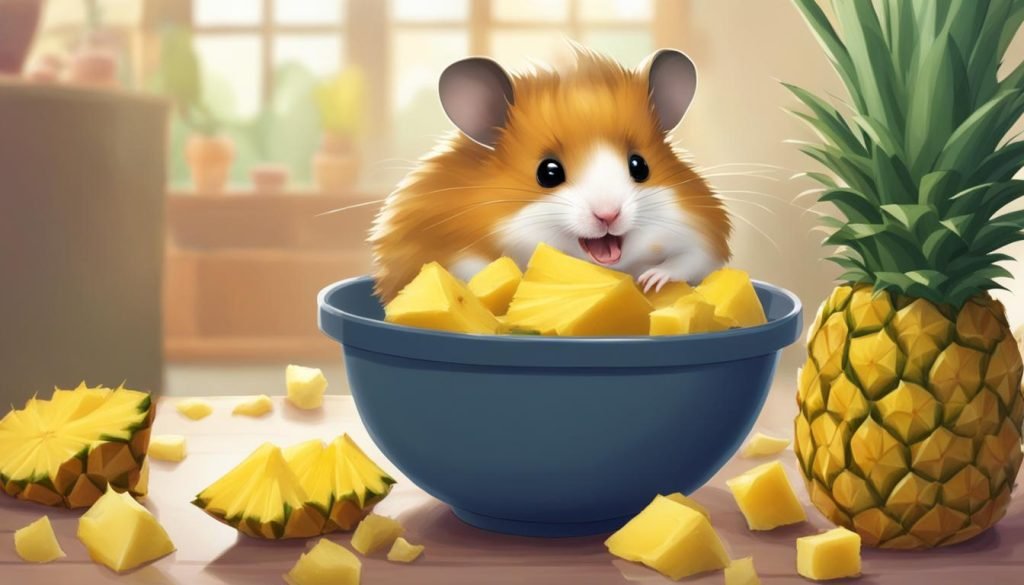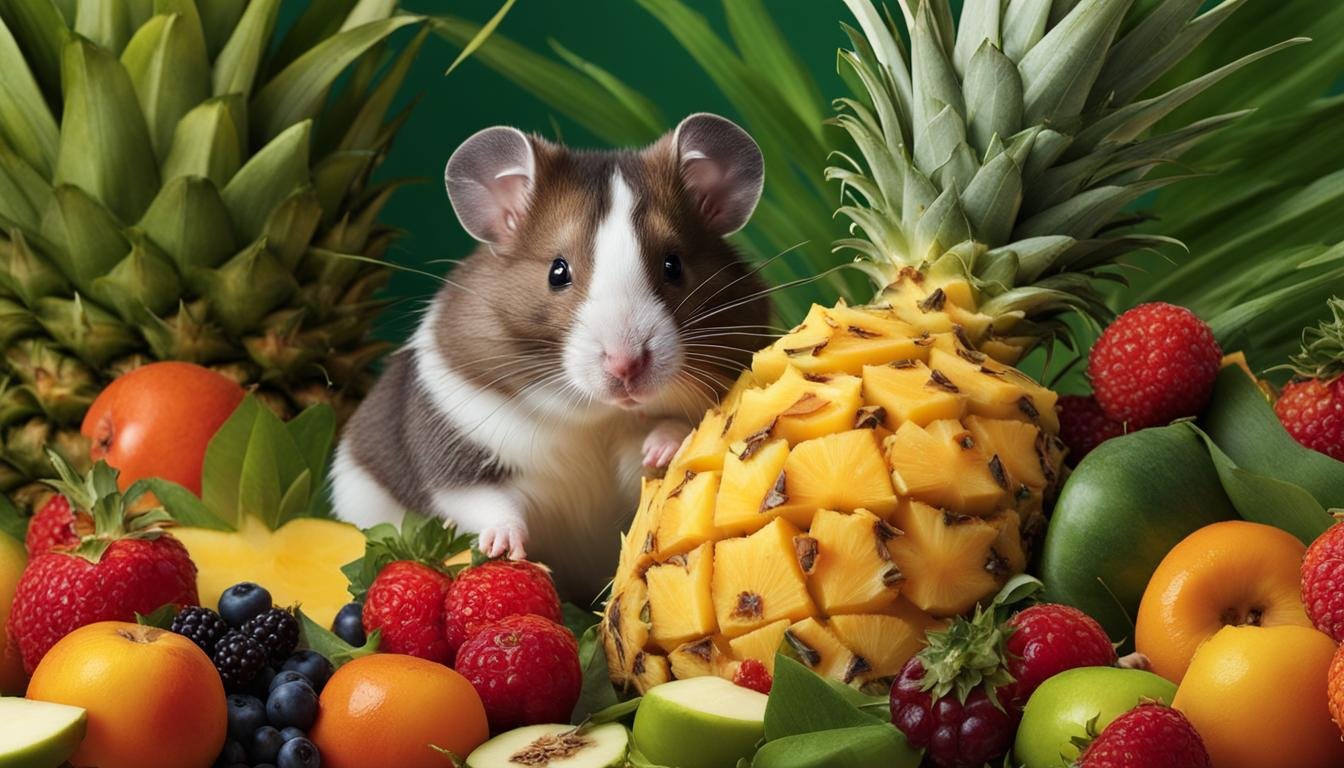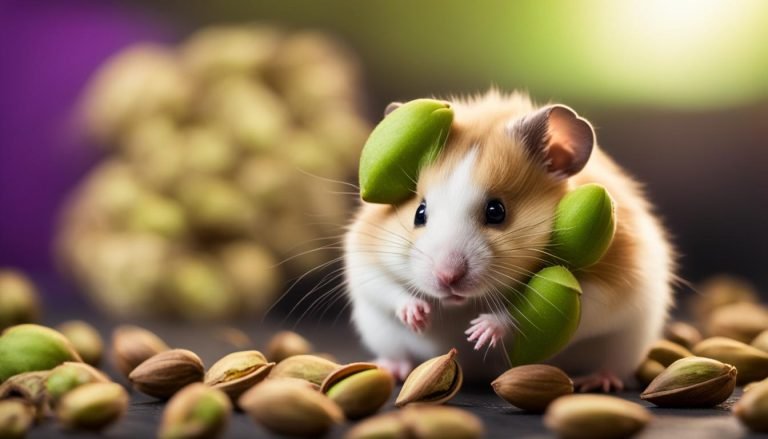Can Hamsters Eat Pineapple? Safe Snack Guide
If you’re wondering whether it’s safe to feed your furry friend pineapple, you’ve come to the right place.
Just like you, I once asked the question “Can hamsters eat pineapple” while I was eating it myself. As a hamster owner myself, I understand the importance of providing a balanced and healthy diet for our little companions and that’s why I have decided to write this post.
In this article, I’ll explore the topic of hamsters and pineapple, discussing the benefits, risks, and best practices for incorporating this tropical fruit into their diet.
Many of us are curious about what fruits are safe for hamsters to eat. Pineapple is one fruit that often raises questions. While hamsters can indeed eat pineapple, it’s essential to remember that it should only be given as an occasional treat and not as a regular part of their diet.
Why, you ask? Let’s dive deeper into the pineapple dilemma and find out.
Key Takeaways:
- Hamsters can eat pineapple, but it should only be given as a treat.
- Pineapple is high in sugar, so moderation is key.
- Small pieces of fresh pineapple, no larger than their paw, can be offered to hamsters.
- Pineapple is rich in vitamins and minerals, including vitamin C, fiber, manganese, and antioxidants.
- Portion sizes should be monitored to avoid weight gain, obesity, and digestive issues.
Can Hamsters Eat Pineapple as a Treat?
Hamsters can have pineapple as a treat, but it should not be a regular part of their diet. While pineapple is safe for hamsters to eat, it is important to give them small pieces and only occasionally. The high sugar content in pineapple can lead to weight gain and obesity in hamsters if consumed in excess.
However, pineapple also contains vitamins and minerals that can provide some health benefits to hamsters. It is a good source of vitamin C, which helps boost their immune system and keeps them healthy. Additionally, pineapple contains fiber, which aids in digestion and keeps the digestive system functioning efficiently.
Pineapple also contains manganese, an important mineral for bone development and wound healing in hamsters. Furthermore, pineapple is rich in antioxidants that help protect its cells from damage.
Overall, pineapple can be a tasty and nutritious treat for hamsters when given in moderation. It is important to remember that hamsters have small digestive systems, so it’s crucial to monitor the amount of pineapple they consume. Providing small, occasional pieces of pineapple can be a delightful addition to their diet.
Risks and Considerations of Feeding Hamsters Pineapple

While pineapple is generally safe for hamsters to eat, there are some risks and considerations to keep in mind. The high sugar content in pineapple can cause weight gain, obesity, and digestive issues in hamsters if they consume too much. The acidity of pineapple can also lead to upset stomach or diarrhea in some hamsters.
It is important to monitor your hamster’s portion sizes and overall health when feeding them pineapple. Offering small, appropriate-sized pieces is crucial to avoid any potential negative effects on their digestive system. Remember, moderation is key.
Additionally, some hamsters may have allergies or sensitivities to pineapple, so it is important to watch for any adverse reactions after introducing this fruit into their diet. If your hamster shows signs of itching, scratching, or digestive discomfort after eating pineapple, it may be best to discontinue feeding it to them.
How to Safely Feed Pineapple to Your Hamster
Feeding pineapple to your hamster can be a delightful and nutritious experience, but it’s essential to take some precautions to ensure their safety and enjoyment. By following a few simple steps, you can introduce this tropical fruit to your furry friend’s diet without any worries.
- Purchase a ripe pineapple: Start by selecting a fresh, ripe pineapple from your local grocery store. Opt for organic if possible, and ensure it is of good quality.
- Thoroughly wash the pineapple: Before preparing the pineapple for your hamster, give it a thorough rinse under cold water to remove any dirt or residue.
- Remove the tough outer skin and core: Carefully cut off the top and bottom of the pineapple. Then, grip the pineapple firmly and slice off the tough outer skin, making sure to remove all the prickly parts. Slice off the woody core as well, as it can be difficult for hamsters to chew and digest.
- Cut into hamster-sized pieces: Take the pineapple flesh and cut it into small pieces or slices that your hamster can easily handle and enjoy. Remember, smaller is better.
- Introduce the pineapple to your hamster: Place one of the pineapple pieces in your hamster’s food dish or directly in their enclosure. Allow them to sniff and explore the fruit, as hamsters rely heavily on their sense of smell to navigate their surroundings.
- Monitor their eating habits: Observe your hamster closely as they eat the pineapple. Make sure they chew and swallow it properly to avoid any choking hazards. If your hamster struggles with the pineapple or shows disinterest, consider cutting the pieces even smaller or trying a different fruit.
- Remove any uneaten pineapple: If your hamster does not finish the pineapple within a few hours, remove any uneaten pieces to prevent spoilage. Fresh food left out for too long can attract pests and lead to health issues for your hamster.
Remember to introduce new foods gradually to your hamster’s diet, including pineapple. Start with a small piece and monitor their reactions over several days. If your hamster shows any signs of allergies, sensitivities, or digestive discomfort, it may be best to discontinue feeding them pineapple.
Final Thoughts
In conclusion, feeding pineapple to hamsters should be approached with caution. While hamsters can enjoy pineapple as a treat, it is important to remember that this fruit is high in sugar and can cause digestive issues if given in large quantities. The key to safely incorporating pineapple into your hamster’s diet is moderation.
Pineapple does offer some health benefits to hamsters when given in small pieces and occasionally. It is a good source of vitamin C, fiber, manganese, and antioxidants, which can contribute to their overall well-being. However, it is essential to monitor your hamster’s portion sizes and closely observe their reaction to the fruit.
If your hamster shows any signs of allergies, sensitivities, or digestive discomfort after eating pineapple, it is best to discontinue feeding it to them. Each hamster is unique, and what works for one may not work for another. Always pay attention to your hamster’s individual needs and consult with a veterinarian if you have any concerns.
Pineapple can be a tasty and nutritious addition to your hamster’s diet when offered responsibly as an occasional treat. Remember to prioritize your hamster’s health and happiness by providing a balanced and varied diet, and always consult with a professional if you have any doubts or questions about their dietary needs.







